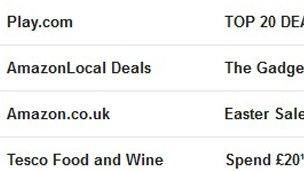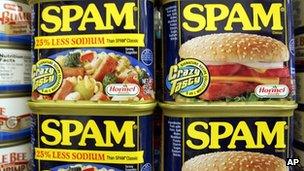Why your inbox fills with bacn instead of spam
- Published

Email inboxes are getting cluttered with lots of almost unwanted messages
It might be heresy for some to say this, but not all bacon is welcome. Especially when we are talking bacn rather than bacon. One is all the not-quite-junk mail messages that land in your inbox and the other is the tasty stuff that sits happily alongside sausages, fried bread and the other cast members of the full English breakfast.
Bacn is becoming what spam once was - the nuisance that fills up your inbox and makes it hard to pick out the important messages you have to read and which require a reply.
Bacn is all those reminders, newsletters, notifications, limited offers, alerts and other ephemera sent by websites, e-tailers and other services you have used ever since you made your first mouse clicks on the web.
It is called bacn because those messages sit in the middle of a short continuum between what tech folks call spam (fake meat/junk mail) and ham (real meat/real mail). Those messages are bacn because they are not quite real messages but are not quite junk either.
"It's a problem in as much as it can get in the way of doing your real work," said Graham Cluley, senior technology consultant at security firm Sophos. "Some people have signed up for so many newsletters and mailing lists it gets hard to find the essential messages.
"Bacn can be a productivity problem." he said, adding that it was stuff you probably wanted to read, just not right now.

Bacn is meatier than spam but not as real as ham
Glance at your email inbox and the bacn is easy to spot - and chances are that there will be quite a lot of it. Many webmail providers, notably Gmail and Hotmail, have introduced tools that help people sweep it into a folder that they can look through later.
In addition, said Mr Cluley, it was possible to use filters and rules in most desktop email programs to spot it and corral it into a folder.
Services are starting to spring up to help people manage that deluge of messages people do not need to read right now but feel they should save - just in case they do suddenly require a case of cheap wine.
John Marbach is the founder of Glider, a start-up that aims to weed out the bacn in your inbox so you can get back to work.
"Every day when I wake up, on my iPhone I see about 20-30 emails that are sent to me automatically and I never open any of them," he said."The problem is these machines sending me messages just to grab my attention."

Social media notifications are another source of not-quite-junk mail
The tools used to stop spam get in the way of stopping these messages precisely because they occupy that hard-to-define space between real junk and real messages. On the one hand, they are legitimate because people have signed up to receive them, they come from reputable web domains and have the same syntax as real messages.
However, they are also slightly spammy because they arrive so regularly and some of their language resembles the hyperbole employed by most junk mail.
What makes them harder to filter out, said Mr Marbach, was that the firms sending them would have tested them against anti-spam tools before they were sent out.
Most bulk mail programs used to manage mailing lists, promotions and other forms of electronic marketing have a test tool that will work out what chance the messages have of getting through industry-standard spam filters.
"This means that other people have access to your attention whenever they want it and I don't think that's right," he told the BBC. By some estimates, he said, only about 10% of the messages people received in their inboxes were real. The rest are bacn.
Glider, as well as other tech firms such as Sanebox, are developing tools that will be able to pick out bacn mail before it reaches the inbox. Others have gone about it in a different way. The Mailbox app for the iPhone tries to enforce good inbox discipline by making people choose what to do with every message they get.
For Mr Marbach, the rise of these tools reveals the struggle many people endure each day just to connect to friends and family. Not surprising when more and more people have to manage not just one inbox but Twitter feeds, timelines, discussion threads, texts and emails. Tech was supposed to make this easier, more nuanced, not turn it into a chore.
"We're all just trying to bring email back to basics and use our inboxes for conversations," he said.
- Published20 March 2013
- Published15 March 2013
- Published12 February 2013
- Published18 December 2012